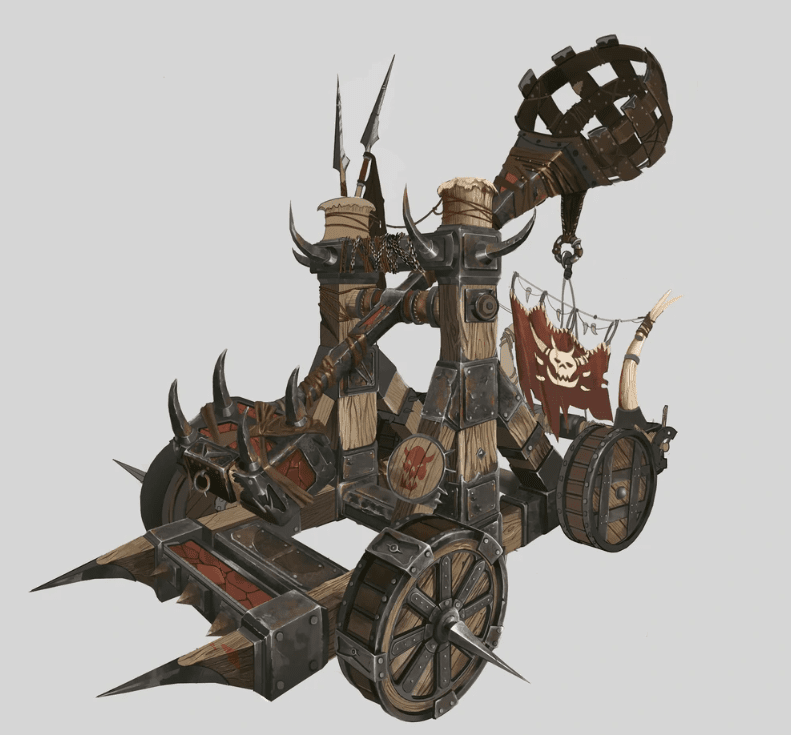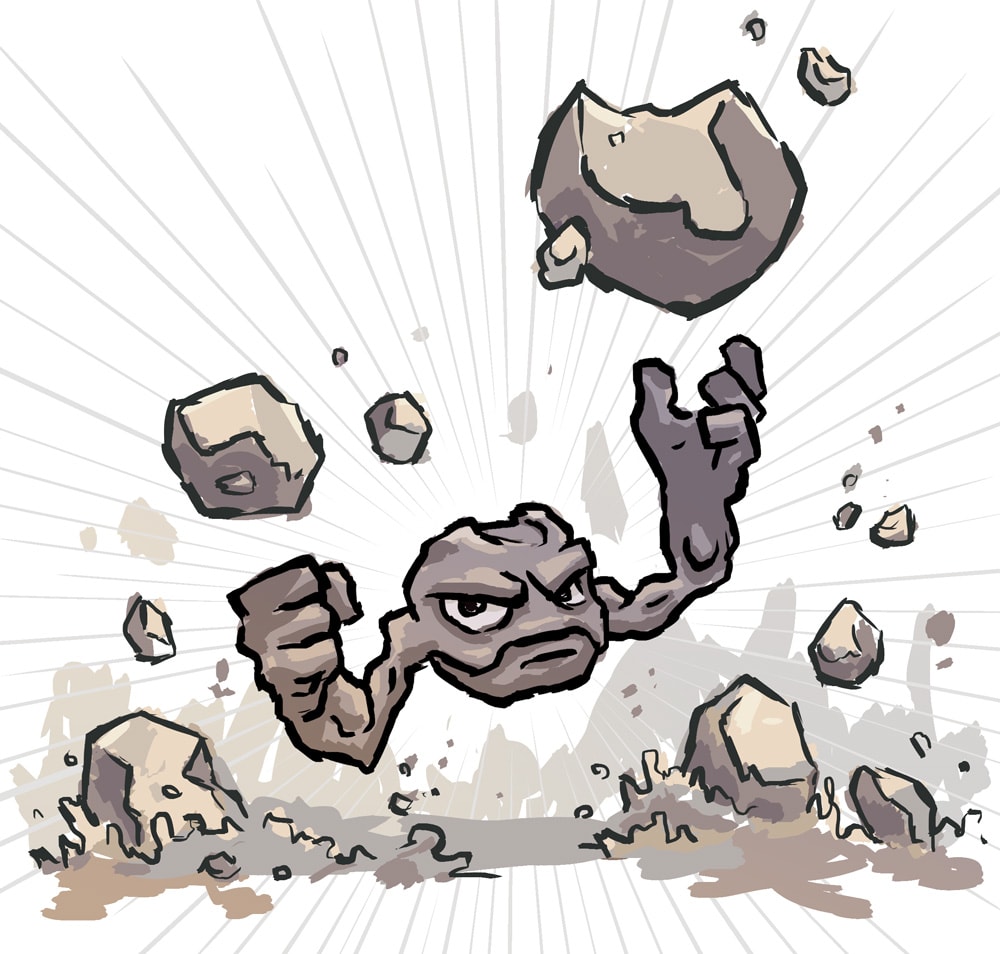A Catapult 5e guide refers to the spell from Xanathar’s Guide to Everything. However, I am going to throw in actual catapults because war weapons are a necessity in certain campaigns.
I love getting creative with my spells and abilities, so Catapult stands out to me. There are so many ways to use it, whereas other damaging 1st level spells are basic damage spells. Talking to you, Magic Missile.
I don’t think that there are any “worthless” D&D spells because I put a lot of stock into the roleplaying aspect. But I do believe that Catapult is a special spell that is severely underused.
Xanathar’s Catapult Spell in DnD 5e

- Level – 1st Level Transmutation
- Casting Time – 1 action
- Range – 60 feet
- Duration – Instant
- Component – S
- Class – Wizard, Sorcerer, Artificer
When you cast Catapult, you choose an object that weighs 1 to 5 pounds that is within the range of the spell. The object then shoots in a straight line up to 90 feet from its current location.
If it hits something, then it will fall. If it hits a creature, that creature must make a Dexterity saving throw. Upon a fail, the creature takes 3d8 bludgeoning damage. The object also takes 3d8 damage when it hits something (even a creature).
You can’t target a held item, so you can’t tear items out of someone’s hands. But you can target any item under 5lbs, and I guess about 1lb and sling it up to 150 feet away from you.
Catapult Spell Rulings

Every spell has rulings, but for some reason, the rulings on Catapult aren’t so easy to dispute. While your DM and your party can decide together what to do, this is the most common way to play.
No Extra Damage
Because it’s just a 1st level spell that already does decent damage, there isn’t a way to “add” damage officially. You can use other spells or abilities that add damage dice, but you can’t add, for example, acid damage just by pouring acid on the object.
No More Range
You can’t add range to the spell unless there is a very specific item, ability, etc. that adds range to spells. The top range for Catapult (unless in an updated version) is 150 feet -which is amazing as it is.
Can Do Less Range
You don’t have to hurl the object the entire 90 feet. You can choose to throw it ten feet or even five feet. The damage doesn’t change depending on how far you throw the item.
Not a “Weapon”
The Catapult and the object are not weapons. So anything that “prevents weapon damage” doesn’t work against the magic bludgeoning damage that the Catapult would do if it hits.
Item Has HP
The item does have HP, but the HP isn’t stated in the spell. Most items have an HP based on their size. A tiny item has around 5-10 HP, while a large one will have up to 80. So you’ll have to look up the exact HP of the item (or something like it).
Item Must Be Inanimate
You cannot launch living creatures, only objects. In the game, an object is a “discrete, inanimate item.” When I say discrete, I mean that it is detached. You can’t use a piece of something as an object unless you detach it first.
Not Just an Attack
A lot of people decide to use Catapult as only an attack spell, but it’s so much more. I would use it to toss an item to a teammate or just because I was lazy and would have to go upstairs to reach them.
Dodge and Keep Going
If the first creature dodges the attack (succeeds on save) and another creature is behind him, then that creature must make a saving throw. This automatically makes Catapult a next-level spell.
Casting Catapult at Higher Levels
If you cast the Catapult spell at higher levels, the maximum weight of the object increases by 5lbs and increases the damage by 1d8 for each level beyond the first. This can really add up.
For example, if you cast the Catapult spell with a level 5 slot, it will do 7d8 damage, and you can use an item that weighs up to 25lbs. This opens up a lot of doors because now you’re throwing medium items.
Catapult 5e (Equipment)
If you want to find a catapult, a real catapult, then you can ask your DM if it is possible to either build one or buy one. The price depends on the size and quality of the catapult, but here are a few ideas.
Light Catapult

- AC – 15
- HP – 20
- Immune – Poison, Psychic
- Cost – Unknown (probably 100 to 200 gp)
The Light Catapult is a siege weapon that a fan created that I feel is fairly balanced. The Light Catapult is a medium object, which means it is around the size of a typical barrel.
It takes one action by one person to load the catapult, one to aim it, and one to fire it. It can fire moderately heavy objects and can hit creatures that are behind cover.
The attack has a range of 150/300 with a minimum range of 60ft. It does 3d10 bludgeoning damage upon hit.
Heavy Catapult
- AC – 30
- HP – 50
- Immune – Poison, Psychic
- Cost – 500 to 1000 gp
- Size – 3 spaces (or 15 feet)
The Heavy Catapult is another custom item. I used the Light Catapult stats to decide what the Heavy Catapult should be, but you can use this as a base and build on it to suit yourself.
The Heavy Catapult takes at least two people to operate. Players must each use an action to load it, aim it, and fire it – it can fire heavy objects. It follows the same rules otherwise.
The range is 200 with a minimum of 100 feet. The catapult does 8d10 bludgeoning damage on it.
Custom Catapult – Bone
- AC – 16
- HP – 80
- Immune – Poison, Psychic
- Cost – can only be made and operated by a Necromancer
This is my favorite custom catapult that I’ve seen. It is a magical item that operates alone after the Necromancer makes it. It gets a turn and takes one action to load and one to fire.
It can also move around at 10 feet per turn with a range of 500 ft (a minimum of 60). When it hits, the target takes 31 (4d10+4) bludgeoning damage. The weapon takes five damage each turn.
Whenever it hits a square, creatures in a 3×3 area (both friend and foe) must make a Dexterity saving throw with a DC of 13 or else be knocked prone.
DM Discretion for Catapult 5e

DM discretion is always at play in Dungeons and Dragons. So there are a few rules that DMs can override, and I’m all for that as long as the DM wants everyone to have a good time.
Stacking Damage
Stacking damage is possible if you get creative enough, and it doesn’t make your 1st level spell overpowered. For example, adding 1d4 elemental damage when you light the object on fire is probably okay past level one.
Adding Conditions
Effects are even better than damage sometimes. Certain items, like a net or flashbang, can bind or blind your foe. There are fifteen conditions in total, and each of them can be achieved creatively.
Grapple
While “grapple” is a condition, in this case, I mean to grapple with a grappling hook. So if you can’t throw the range you need to, then you can use Catapult to ensure you can “throw” up to 150 feet.
Hitting a Soft Surface
The spell says that if the item hits a “solid surface,” it ends. However, it doesn’t say anything about soft surfaces. This is something you’ll have to discuss with your DM. Does it lessen the impact?
Interesting Ways to Use Catapult

There are a million creative ways to use the Catapult spell, which is why I love it. While there are many more ways than I will list, I want to give a few ideas as to how to use this amazing spell.
Throwing Across the Balcony
Let me start with something simple – throwing things. Imagine your party splits up and meets again; only you are on different balconies 60 feet apart. You have the key, and your other party members have the door. Throw the keys over with Catapult!
Solving Puzzles
This won’t work on all puzzles, but if it’s a Zelda-like press-the-button puzzle, then you can throw an object onto the switch. Again, quite situational, but you get the gist of how it works.
Breaking Stuff
You can use Catapult to break a wall down, especially if used at a higher level. This is a good way to see what’s behind something without having to get close enough to find out the hard way.
Throw Oil Jars
I love this concept. While you can’t typically add fire damage to your Catapult, you can do damage while setting an enemy up for fire damage. Catapult oil jars or flasks, then follow up with fire attacks on your next turn.
Flare Gun
You can shoot fireworks in the air creatively to create a flare gun if your party gets separated. This is a good way to have fun with your Catapult while still providing something useful, just don’t hit your Ranger hawk.
Disarming
You can’t use Catapult on a held item, but you can use it on a sword that the enemy has dropped temporarily. So try to disarm them, then shoot their weapon far away so they can’t get it back.
Return Attacks
Imagine a bomb is thrown at you. It would be easy – especially when not in combat – to toss it back with Catapult, unless the DM decides to be a jerk and make it impossible for the bomb not to explode first.
Move Something Towards You
This is my favorite method for Catapult. There’s nothing in the description that says you have to move things “forward.” You can bring something to you, which has endless possibilities. Kill the mimic before it can reach you, or grab the gem without triggering traps!
FAQs
Question: How Fast Does a Catapulted Object Travel?
ANSWER: The average round is 6 seconds long, and the item travels at a maximum of 90 feet in that time. That is a maximum of 15 feet per second or ten miles per hour. Not very fast, but effective.
QUESTION: DOES THE CATAPULTED OBJECT ARCH OR CURVE IN DND?
ANSWER: No. The object must travel in a straight line. Despite the name, you cannot use a trajectory formula to create a curve that gives you more control over the object’s path.
QUESTION: HOW DO YOU RESIST CATAPULT 5E DAMAGE?
ANSWER: It isn’t easy to resist the damage coming from the catapult, but it is bludgeoning damage. Even if it isn’t from a weapon, many abilities don’t specify the type of resistance other than saying “Bludgeoning.”
QUESTION: WHAT DOES CATAPULT 5E LOOK LIKE?
ANSWER: The “Catapult” part of the spell isn’t visible. I imagine the object flies through the air with few particles around it. Instead, it would likely look like an object being thrown (yet still only traveling ten mph).
QUESTION: DOES WEIGHT EFFECT CATAPULT DAMAGE?
ANSWER: No. This would complicate things. The weight of the object does not affect the damage, even though it seems like it should. The dm can get around this, but it may be too much math for the trouble.
Catapult 5e – Worth It or Not?
Catapult 5e does decent damage for a 1st level spell. I think it’s worth it even if it didn’t do damage because getting an object from point A to point B in a short amount of time, over any terrain, is beneficial.
But it does do damage and good damage at that. It doesn’t have minimum damage before dice damage is added, but I think that 3 to 24 damage is fair. After all, that would possibly kill any 1st-level player.
The average 1st-level player probably has around 10 HP. So I think that’s more than enough damage even without the utility. But of course, utility means everything to me and my roleplaying heart.
- Augury 5e Guide – The Vaguest and Coolest Cleric Spell - September 5, 2022
- Roc 5e Guide – The Big, Dumb Bird You Don’t Want To See - September 5, 2022
- Best Drow Name Ideas – From Alvin to Sânziana - August 30, 2022



